[Editor’s Note: Story Telling is a powerful tool that allows us to envision how innovative and potentially disruptive technologies could be employed and operationalized in the Future Operational Environment. In today’s guest blog post, proclaimed Mad Scientist Mr. August Cole and Mr. Amir Husain use story telling to effectively:
- Describe what the future might look like if our adversaries out-innovate us using Artificial Intelligence and cheap robotics;
- Address how the U.S. might miss a strategic breakthrough due to backward-looking analytical mindsets; and
- Imagine an unconventional Allied response in Europe to an emboldened near-peer conflict.
Enjoy reading how the NATO Alliance could react to Omega — “a Russian autonomous joint force in a … ready-to-deploy box… [with an] area-denial bubble projected by their new S-600s extend[ing] all the way to the exo-sphere, … cover[ing] the entirety of the ground, sea and cyber domains” — on the cusp of a fictional not-so-distant future near-peer conflict!]
Omega
22 KILOMETERS NORTH OF KYIV / UKRAINE
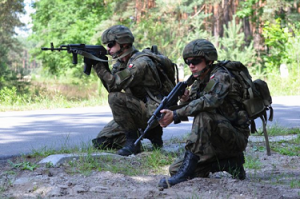 “Incoming!” shouted Piotr Nowak, a master sergeant in Poland’s Jednostka Wojskowa Komandosów special operations unit. Dropping to the ground, he clawed aside a veil of brittle green moss to wedge himself into a gap beneath a downed tree. He hoped the five other members of his military advisory team, crouched around the fist-shaped rock formation behind him, heard his shouts. To further reinforce Ukraine’s armed forces against increasingly brazen Russian military support for separatists in the eastern part of the country, Poland’s government had been quietly supplying military trainers. A pro-Russian military coup in Belarus two weeks earlier only served to raise tensions in the region – and the stakes for the JWK on the ground.
“Incoming!” shouted Piotr Nowak, a master sergeant in Poland’s Jednostka Wojskowa Komandosów special operations unit. Dropping to the ground, he clawed aside a veil of brittle green moss to wedge himself into a gap beneath a downed tree. He hoped the five other members of his military advisory team, crouched around the fist-shaped rock formation behind him, heard his shouts. To further reinforce Ukraine’s armed forces against increasingly brazen Russian military support for separatists in the eastern part of the country, Poland’s government had been quietly supplying military trainers. A pro-Russian military coup in Belarus two weeks earlier only served to raise tensions in the region – and the stakes for the JWK on the ground.
An instant later incoming Russian Grad rocket artillery announced itself with a shrill shriek. Then a rapid succession of sharp explosive pops as the dozen rockets burst overhead. Nowak quickly realized these weren’t ordinary fires.
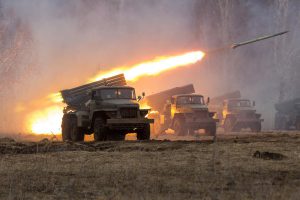
There was no spray of airburst shrapnel or the lung-busting concussion of a thermobaric munition. Instead, it sounded like summer fireworks – the explosive separation of the 122mm rocket artillery shell’s casing. Once split open, each weapon’s payload deployed an air brake to slow its approach.
During that momentary silence, Nowak edged out slightly from under the log to look up at the sky. He saw the drifting circular payload extend four arms and then, suddenly, it came to life as it sprang free of its parachute harness. With a whine from its electric motors, the quadcopter darted out of sight.
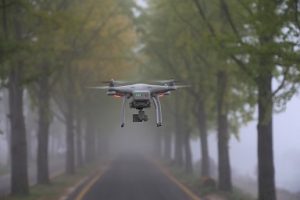
That sound built and built over the next minute as eleven more of these Russian autonomous drones darted menacingly in a loose formation through the forest above the Polish special operations commandos. Nowak cursed the low-profile nature of their mission: The Polish soldiers had not yet received the latest compact American counter-UAS electronic-warfare systems that could actually fit in their civilian Skoda Kodiaq SUVs.
Nowak held his airplane-mode mobile phone out from under the log to film the drones, using his arm like a selfie-stick. Nowak needed to report in what he was seeing – this was proof Russian forces had turned their new AI battle management system online inside Ukraine. But he also knew that doing so would be a death sentence, whether he texted the video on the country’s abominably slow mobile networks or used his secure NATO comms. These Russian drones could detect either type of transmission in an instant. Once the drones cued to his transmission he would be targeted either by their own onboard anti-personnel munitions or a follow-on strike by conventional artillery.
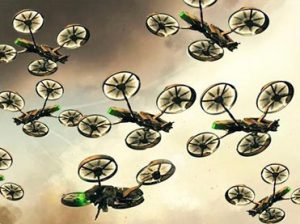 This was no mere variation on the practice of using Leer-3 drones for electronic warfare and to spot for Russian artillery. It marked the first-ever deployment of an entirely new Russian AI battle system complex, Omega. Nowak had only heard about the Russians firing entire drone swarms from inexpensive Grad rocket-artillery rounds once before in Syria while deployed with a US task force. But they had never done so in Ukraine, at least not that he knew about. Most observers chalked up Russia’s Syrian experimentations with battlefield robots and drone swarms to clumsy failures. Clearly something had changed.
This was no mere variation on the practice of using Leer-3 drones for electronic warfare and to spot for Russian artillery. It marked the first-ever deployment of an entirely new Russian AI battle system complex, Omega. Nowak had only heard about the Russians firing entire drone swarms from inexpensive Grad rocket-artillery rounds once before in Syria while deployed with a US task force. But they had never done so in Ukraine, at least not that he knew about. Most observers chalked up Russia’s Syrian experimentations with battlefield robots and drone swarms to clumsy failures. Clearly something had changed.
With his phone, Nowak recorded how the drones appeared to be coordinating their search activities as if they were a single hive intelligence. They divided the dense forest into cells they searched cooperatively. Within seconds, they climbed and dove from treetop height looking for anyone or anything hiding below.
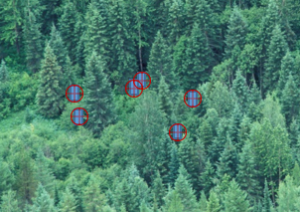 At that very instant, the drone’s computer vision algorithms detected Novak’s team. Each and every one of them. Within seconds, six of the aggressively maneuvering drones revealed themselves in a disjointed dive down from the treetops and zoomed in on the JWK fighters’ positions.
At that very instant, the drone’s computer vision algorithms detected Novak’s team. Each and every one of them. Within seconds, six of the aggressively maneuvering drones revealed themselves in a disjointed dive down from the treetops and zoomed in on the JWK fighters’ positions.
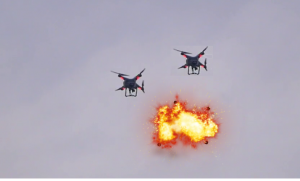 Nobody needed to be told what to do. The team raised their weapons and fired short bursts at the Russian drones. One shattered like a clay pigeon. But two more buzzed into view to take its place. Another drone went down to a shotgun-fired SkyNet round. Then the entire drone formation shifted its flight patterns, dodging and maneuvering even more erratically, making it nearly impossible to shoot the rest down. The machines learned from their own losses, Nowak realized. Would his superiors do the same for him?
Nobody needed to be told what to do. The team raised their weapons and fired short bursts at the Russian drones. One shattered like a clay pigeon. But two more buzzed into view to take its place. Another drone went down to a shotgun-fired SkyNet round. Then the entire drone formation shifted its flight patterns, dodging and maneuvering even more erratically, making it nearly impossible to shoot the rest down. The machines learned from their own losses, Nowak realized. Would his superiors do the same for him?
Nowak emptied his magazine with a series of quick bursts, but rather than reload he put his weapon aside and rolled out from under the log. Fully exposed and clutching the phone with shaking hands, he hastily removed one of his gloves with his teeth. Then he switched the device on. Network connected. He scrolled to the video of the drones. Send! Send! Send!
Eleven seconds later, Novak’s entire Polish JWK special forces team lay dead on the forest floor.

________________________________
Omega is not any one specific weapon, rather it is made up of a menagerie of Russian weapons, large and small. It’s as if you fused information warfare, SAMs, fires, drones, tactical autonomous bots… There’s everything from S-600 batteries to cheap Katyusha-style rocket artillery to Uran-9 and -13 tanks. But it is what controls the hardware that makes Omega truly unique: AI. At its core, it’s an artificial intelligence system fusing data from thousands of sensors, processed information, and found patterns that human eyes and minds cannot fathom. The system’s AI is not only developing a comprehensive real-time picture, it’s also developing probabilities and possible courses of enemy action. It can coordinate thousands of “shooters”, from surface-to-air missiles, to specialized rocket artillery deploying autonomous tactical drones like the ones that killed the JWK team, to UGVs like the latest Uran-13 autonomous tracked units.
The developers of the Omega system incorporated technologies such as software-defined radio, which uses universal receivers that could listen in to a broad array of frequencies. Thousands of these bands are monitored with machine learning algorithms to spot insurgent radio stations, spy on the locations of Ukrainian military and police, and even determine if a certain frequency is being used to remotely control explosives or other military equipment. When a threat is discovered, the system will dispatch drones to observe the triangulated location of the source. If the threat needs to be neutralized a variety of kinetic systems – from guided artillery shells to loitering munitions and autonomous drones – can be dispatched for the kill.
________________________________
If you enjoyed this excerpt, please:
Read the complete Omega short story, hosted by our colleagues at the Atlantic Council NATOSource blog,
Learn how the U.S. Joint Force and our partners are preparing to prevail in competition with our strategic adversaries and, when necessary, penetrate and dis-integrate their anti-access and area denial systems and exploit the resultant freedom of maneuver to achieve strategic objectives (win) and force a return to competition on favorable terms in The U.S. Army in Multi-Domain Operations 2028 Executive Summary, and
See one prescription for precluding the strategic surprise that is the fictional Omega in The Importance of Integrative Science/Technology Intelligence (InS/TINT) to the Prediction of Future Vistas of Emerging Threats, by Dr. James Giordano, CAPT (USN – Ret.) L. R. Bremseth, and Mr. Joseph DeFranco.
Reminder: You only have 1 week left to enter your submissions for the Mad Scientist Science Fiction Writing Contest 2019. Click here for more information about the contest and how to submit your short story(ies) for consideration by our 1 April 2019 deadline!
Mr. August Cole is a proclaimed Mad Scientist, author, and futurist focusing on national security issues. He is a non-resident senior fellow at the Art of the Future Project at the Atlantic Council. He also works on creative foresight at SparkCognition, an artificial intelligence company, and is a senior advisor at Avascent, a consulting firm. His novel with fellow proclaimed Mad Scientist P.W. Singer, entitled Ghost Fleet: A Novel of the Next World War, explores the future of great power conflict and disruptive technologies in wartime.
Mr. Amir Husain is the founder and CEO of SparkCognition, a company envisioned to be at the forefront of the “AI 3.0” revolution. He serves as advisor and board member to several major institutions, including IBM Watson, University of Texas Department of Computer Science, Makerarm, ClearCube Technology, uStudio and others; and his work has been published in leading tech journals, including Network World, IT Today, and Computer World. In 2015, Amir was named Austin’s Top Technology Entrepreneur of the Year.
Disclaimer: This publication is a work of fiction by Messrs. August Cole and Amir Husain, neither of whom have any affiliation with U.S. Army Training and Doctrine Command, the U.S. Army, or the U.S. Government. This piece is meant to be thought-provoking and entertaining, and does not reflect the current position of the U.S. Army.

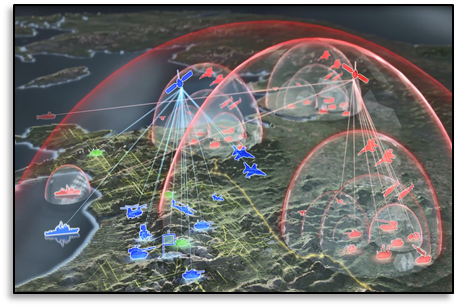


So what I’m inferring here is the return to actual IPB that looks not just at the standard “65% of IPB is done in garrison” but a 2nd and 3rd order effect aspect related to how potential future adversaries have sized us up and focused on the seams (i.e., we rely heavily on commercial satellites which are not ruggedized for military operations like our power/tough books are).
Identifying the inherent weaknesses of delivery systems, supporting aspects (lack of bandwidth and encrypted WiFi means using more traditional ways of moving data), alongside the actual IPB and knowledge of weapons systems.
We don’t teach this do we? It is a critical thinking aspect (and we don’t teach that well either) until university/college (maybe) and not clear to me that Officer Basic/Advanced Courses or AIT/NCOES does either–may be I’m wrong and I’d like to be but until it’s more inherent I’ll remain cynical.
We took “branches and sequels” from Soviet doctrine and incorporated it into ours; time to take “seam IPB” from Chinese and Russian doctrine and mesh with our conflated JIPOE and develop a “new baseline” for how to to IPB that includes the 2s being the Red Commanders again and getting leaders at various levels what they need regardless of timidity or egos.